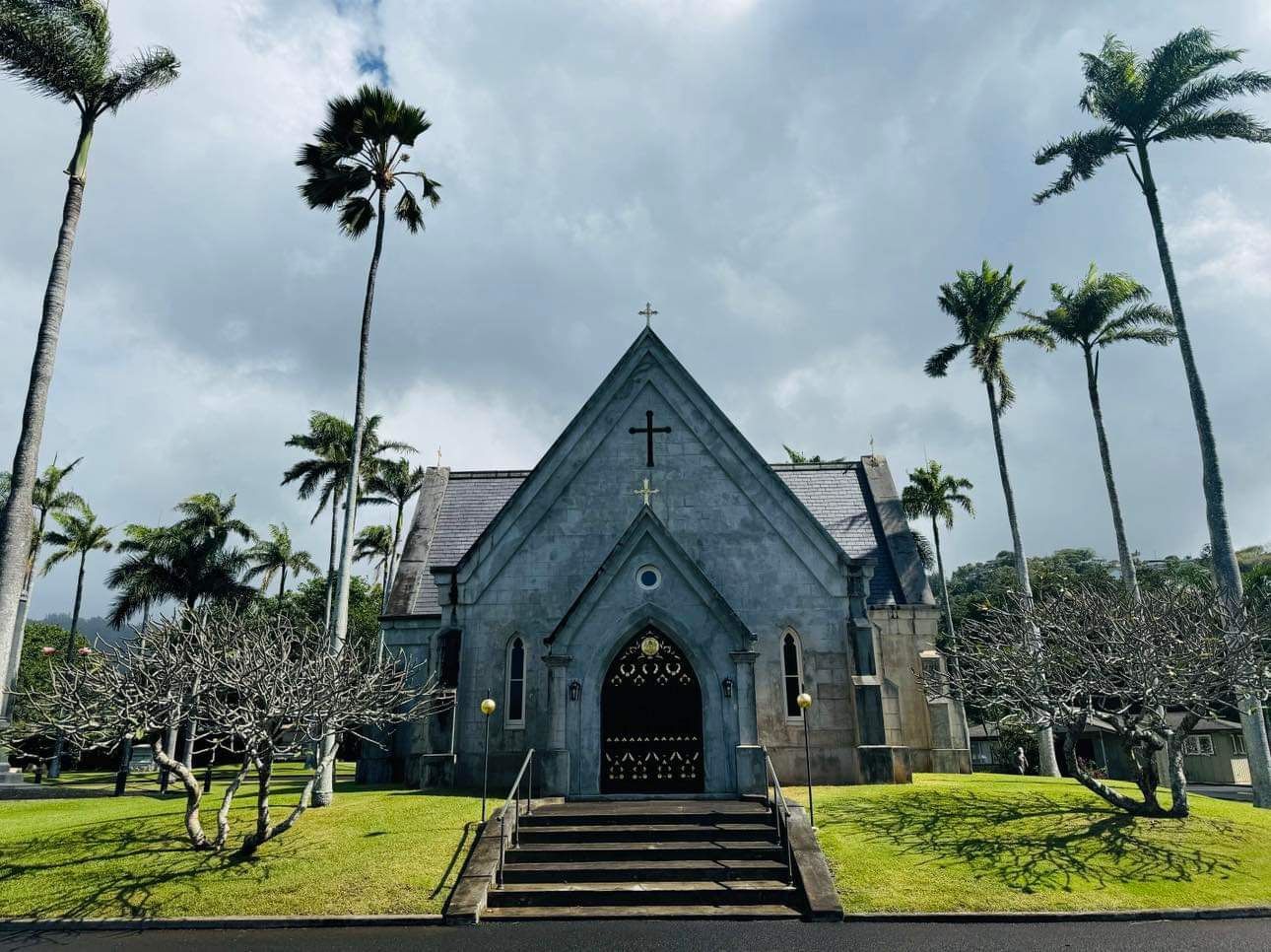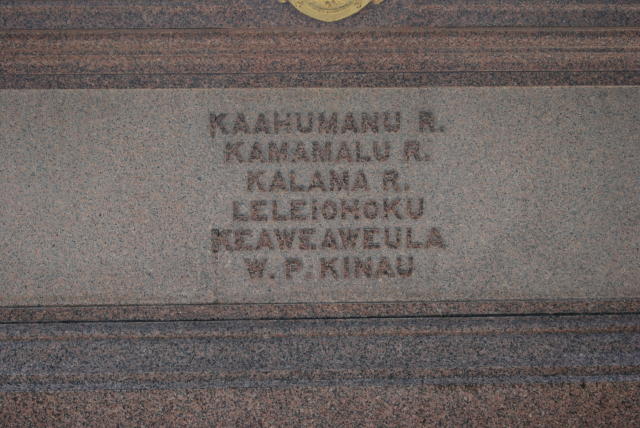Her father was King Kamehameha I and mother was his sixth wife Queen Kalākua Kaheiheimālie. She was born on the island of Oʻahu at Waikiki. She was given in hānai to her stepmother Peleuli and her second husband Kawelookalani, her father's half-brother. Peleuli named her Kīnaʻu after her son Kahōʻanokū Kīnaʻu (her half-brother) and took her back to the island of Hawaii after Kamehameha moved his capital back to Kailua-Kona.
Kīnaʻu was first married to her half-brother Liholiho (1797–1824) who ascended in 1819 as King Kamehameha II. In 1824, quite young, she became Dowager Queen when Kamehameha II died in London together with his favorite wife (her sister) Queen Kamāmalu.
Her second husband was Kahalaiʻa Luanuʻu, a grandson of Kamehameha I. She had two children, one who was adopted by another high ranking chiefly family and the other a son who perished along with his father in the whooping cough epidemic of 1826.
Her third husband was Mataio Kekūanāoʻa (1791–1868), from 1827. Kekūanāoʻa was Governor of Oʻahu 1834–1868. To him she bore four sons: David Kamehameha (1828–1835), Moses Kekūāiwa (1829–1848), Lot Kapuāiwa (1830–1873), and Alexander Liholiho (1830–1873), and one daughter Victoria Kamāmalu (1838–1866).
She became the Kuhina Nui (an office somewhat like Prime Minister or co-regent) styled as Kaʻahumanu II June 5, 1832 when Queen Kaʻahumanu died. She acted as the Regent for her brother Kauikeaouli when he became King Kamehameha III, from June 5, 1832 to March 15, 1833. She would rule with him until her death. She was responsible for enforcing Hawaii's first penal code, proclaimed by the king in 1835. She adopted Protestant Christianity like many of the chiefs and chiefesses. She persecuted many of the Catholic missionaries and tried to expel the French Jesuit Priests, which would later lead into diplomatic troubles with France.
Kīnaʻu and Kamehameha III argued over government policies. Kīnaʻu favored the policies recommended by the missionaries and was not as tolerant of other religions as her predecessor, Kaʻahumanu. She strengthened the land tenure of the Crown Lands by written and official proclamation. Kamehameha III resented the lessened power of the king who no longer had sole power to give and take land at will. He wanted the old ways for his people. Eventually they resolved their differences and formed a new government. Now there was a King, a Kuhina Nui, and a Counsel of Chiefs.
Her two sons from her third husband who survived to adulthood ascended as kings of Hawaii: the younger Alexander Liholiho as Kamehameha IV and then Lot Kapuāiwa as Kamehameha V. Her only daughter Victoria Kamāmalu became Kuhina Nui as Kaʻahumanu IV.
Kaʻahumanu II died of the mumps at Honolulu, Oʻahu on April 4, 1839.
Her father was King Kamehameha I and mother was his sixth wife Queen Kalākua Kaheiheimālie. She was born on the island of Oʻahu at Waikiki. She was given in hānai to her stepmother Peleuli and her second husband Kawelookalani, her father's half-brother. Peleuli named her Kīnaʻu after her son Kahōʻanokū Kīnaʻu (her half-brother) and took her back to the island of Hawaii after Kamehameha moved his capital back to Kailua-Kona.
Kīnaʻu was first married to her half-brother Liholiho (1797–1824) who ascended in 1819 as King Kamehameha II. In 1824, quite young, she became Dowager Queen when Kamehameha II died in London together with his favorite wife (her sister) Queen Kamāmalu.
Her second husband was Kahalaiʻa Luanuʻu, a grandson of Kamehameha I. She had two children, one who was adopted by another high ranking chiefly family and the other a son who perished along with his father in the whooping cough epidemic of 1826.
Her third husband was Mataio Kekūanāoʻa (1791–1868), from 1827. Kekūanāoʻa was Governor of Oʻahu 1834–1868. To him she bore four sons: David Kamehameha (1828–1835), Moses Kekūāiwa (1829–1848), Lot Kapuāiwa (1830–1873), and Alexander Liholiho (1830–1873), and one daughter Victoria Kamāmalu (1838–1866).
She became the Kuhina Nui (an office somewhat like Prime Minister or co-regent) styled as Kaʻahumanu II June 5, 1832 when Queen Kaʻahumanu died. She acted as the Regent for her brother Kauikeaouli when he became King Kamehameha III, from June 5, 1832 to March 15, 1833. She would rule with him until her death. She was responsible for enforcing Hawaii's first penal code, proclaimed by the king in 1835. She adopted Protestant Christianity like many of the chiefs and chiefesses. She persecuted many of the Catholic missionaries and tried to expel the French Jesuit Priests, which would later lead into diplomatic troubles with France.
Kīnaʻu and Kamehameha III argued over government policies. Kīnaʻu favored the policies recommended by the missionaries and was not as tolerant of other religions as her predecessor, Kaʻahumanu. She strengthened the land tenure of the Crown Lands by written and official proclamation. Kamehameha III resented the lessened power of the king who no longer had sole power to give and take land at will. He wanted the old ways for his people. Eventually they resolved their differences and formed a new government. Now there was a King, a Kuhina Nui, and a Counsel of Chiefs.
Her two sons from her third husband who survived to adulthood ascended as kings of Hawaii: the younger Alexander Liholiho as Kamehameha IV and then Lot Kapuāiwa as Kamehameha V. Her only daughter Victoria Kamāmalu became Kuhina Nui as Kaʻahumanu IV.
Kaʻahumanu II died of the mumps at Honolulu, Oʻahu on April 4, 1839.












